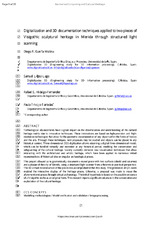Mostrar el registro sencillo del ítem
Digitalization and 3D Documentation Techniques Applied to Two Pieces of Visigothic Sculptural Heritage in Merida Through Structured Light Scanning
| dc.contributor.author | García Molina, Diego Francisco | |
| dc.contributor.author | López-Lago, Samuel | |
| dc.contributor.author | Hidalgo Fernández, Rafael E. | |
| dc.contributor.author | Triviño Tarradas, Paula María | |
| dc.date.accessioned | 2024-02-06T13:47:42Z | |
| dc.date.available | 2024-02-06T13:47:42Z | |
| dc.date.issued | 2021 | |
| dc.identifier.uri | http://hdl.handle.net/10396/27172 | |
| dc.description.abstract | Technological advancements have a great impact on the dissemination and understanding of the cultural heritage reality due to innovative techniques. These innovations are based on high-precision and high-resolution technologies that allow for the geometric documentation of any object within the fields of history and the arts. Through these techniques, new proposals may be studied and objects can be placed in any historical context. Three-dimensional (3D) digitization allows one to obtain a digital 3D model, which can be handled virtually and recreated at any historical period, enabling the conservation and safeguarding of cultural heritage. Society currently demands new visualization techniques that allow interacting with architectural and artistic heritage, which have been applied in numerous virtual reconstructions of historical sites or singular archaeological pieces. This project allowed us to geometrically document a reused piece with two surfaces (shield and columns) and a plaque of the city of Merida using a structured light scanner from a theoretical-practical perspective. The 3D virtual reconstruction of the pieces was accomplished within this study. The generation of QR codes enabled the interactive display of the heritage pieces. Likewise, a proposal was made to reuse the aforementioned pieces through virtual archaeology. The initial hypothesis is based on the possible existence of a Visigothic niche as an original form. This research reports significant advances in the conservation and exploitation of cultural heritage. | es_ES |
| dc.format.mimetype | application/pdf | es_ES |
| dc.language.iso | eng | es_ES |
| dc.publisher | Association for Computing Machinery | es_ES |
| dc.rights | https://creativecommons.org/licenses/by-nc-nd/4.0/ | es_ES |
| dc.source | García–Molina, D. F., López-Lago, S., Hidalgo-Fernández, R. E., & Triviño-Tarradas, P. (2021). Digitalization and 3D documentation techniques applied to two pieces of visigothic sculptural heritage in Merida through structured light scanning. Journal on computing and cultural heritage, 14(4), 1-19. https://doi.org/10.1145/3427381 | es_ES |
| dc.subject | Three-dimensional geometric documentation | es_ES |
| dc.subject | Structured light scanning | es_ES |
| dc.subject | Virtual archaeology | es_ES |
| dc.subject | Cultural heritage | es_ES |
| dc.subject | 3D reconstruction | es_ES |
| dc.subject | Digital conservation technique | es_ES |
| dc.title | Digitalization and 3D Documentation Techniques Applied to Two Pieces of Visigothic Sculptural Heritage in Merida Through Structured Light Scanning | es_ES |
| dc.type | info:eu-repo/semantics/article | es_ES |
| dc.relation.publisherversion | https://doi.org/10.1145/3427381 | es_ES |
| dc.rights.accessRights | info:eu-repo/semantics/openAccess | es_ES |

